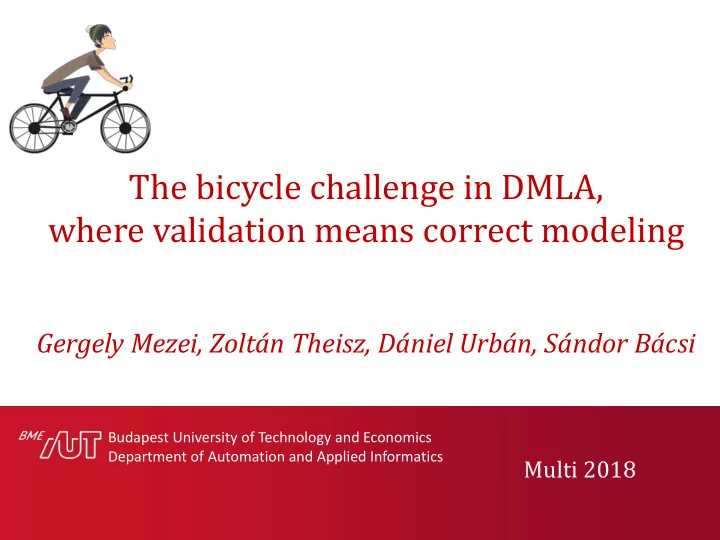

The bicycle challenge in DMLA, where validation means correct modeling Gergely Mezei, Zoltán Theisz, Dániel Urbán, Sándor Bácsi Budapest University of Technology and Economics Department of Automation and Applied Informatics Multi 2018
Dynamic Multi-Layer Algebra • Core (the “HW”)– Data structure – Based on Abstract State Machines – Data structure and management – 4-tuple {X ID , X Meta , X values, X Attributes } • Bootstrap (the “operating system”) – Set of entities, enabler of modeling – Defines metamodeling foundation – Basic building blocks (modelling and operations) • DMLAScript (the “programming language”) – The “sugar” – Higher abstraction level interface (no tuples) – Always compiled to entities 2
DMLA – Instantiation • Fluid metamodeling (#Ulrich: RC1, RC2) – Intention: support stepwise, partial refinement • Concretization everything at once (a whole level) is rigid – Entities/attributes are instantiated individually – (Partial) Instantiation – mixture of • Concretization: the abstraction level is lowered • Cloning: the entity/feature remains intact (#Ulrich RC7) MountainBike Bicycle Wheel CityBike Wheel > Suspension Features Wheel Features 3
DMLA – Validated operations Goal: self validating bootstrap (without an external language) • – Key: we need to model the operations – AST elements Bootstrap – Operation definitions are built from entities A high level script language (DMLAScript) was invented Validation formulae • – Alpha : meta – instance (1:1, e.g. type) – Beta : meta – set of instances (1:n, e.g. cardinality) – Gamma : instance – whole model (1:*, e.g. uniqueness) – Entities can extend their formulae, but validation is always enforced through the hierarchy up to the root element Alpha validation Bicycle Configuration Components Wheel Seat Beta validation Fork 4
DMLA - slots • Slots – features of entities – Constraints – reusable validation logic • Type, Cardinality (#Ulrich: RC3) • Operation signature • Must-Fill-Once • Extendable and fully modeled validation (e.g. filtered cardinality) – ComplexEntity.Children • Universal type, unlimited cardinality • The source of adding new features 5
Slots BicycleEntity: ComplexEntity Children : ComplexEntity.Children {T: $Base, C: 0..*} Component: BicycleEntity Children: ComplexEntity.Children {T: $Base, C: 0..*} Weight : ComplexEntity.Children {T: $ Number , C: 1..1 } Configuration: BicycleEntity Children: ComplexEntity.Children {T: $Base, C: 0..*} Components : ComplexEntity.Children {T: $ Component , C: 0..* } 6
Inheritance “emulation” Component: BicycleEntity Children: ComplexEntity.Children {T: $Base, C: 0..*} Weight : ComplexEntity.Children {T: $ Number , C: 0..*} Frame: Component Children: ComplexEntity.Children {T: $Base, C: 0..*} Weight: ComplexEntity.Children {T: $Number, C: 0..*} Length : ComplexEntity.Children {T: $Number, C: 0..*} Seat: Component Children: ComplexEntity.Children {T: $Base, C: 0..*} Weight: ComplexEntity.Children {T: $Number, C: 0..*} 7
Gradual type constraints Configuration: BicycleEntity Children: ComplexEntity.Children {T: $Base, C: 0..*} Components : ComplexEntity.Children {T: $ Component , C: 0..* } Ncycle: Configuration Children: ComplexEntity.Children {T: $Base, C: 0..*} Components: ComplexEntity.Children {T: $Component, C: 0..*} Fork : Configuration.Components {T: $ Fork , C: 1..1 } Seat : Configuration.Components {T: $ Seat , C: 1..3 } Wheel : Configuration.Components {T: $ Wheel , C: 1..2 } Bicycle: Ncycle Tandem: Ncycle Unicycle: Ncycle 8
Gradual type constraints Bicycle: NCycle Children: ComplexEntity.Children {T: $Base, C: 0..*} Components: ComplexEntity.Children {T: $Component, C: 0..*} Fork: Ncycle.Fork {T: $Fork, C: 1..1} Seat : Ncycle.Seat {T: $ Seat , C: 1..1 } RaceBike: Bicycle … Fork : Ncycle.Fork {T: $ RaceFork , C: 1..1} … ProRaceBike: RaceBike … Fork : RaceBike.Fork {T: $ ProRaceFork , C: 1..1} … ChallengerA2XL: ProRaceBike … Fork : ProRaceBike.Fork {T: $ RocketA1XL , C: 1..1} … 9
Concrete objects • What does “physical object” mean? – You can touch it? – Can you touch a concrete bike, or only its components? – Is a concrete bicycle without wheels still a bike? Do the wheels still belong to the bike? – Serial number of components are unique – but this stands only for concrete components 10
Concrete objects • Concrete objects – All primitive slots are filled with a value – All non-primitive slots have a concrete value – Has no more “free” slots • Human + DMLA validation – Flag-driven validation – Concreteness is “claimed” – The statement is validated by DMLA 11
Derived attributes – built-in calculations • Get average sales price of a – …concrete model – …a category of models – …a type of bicycle • Why do not we use the instantiation chain? • Calculation = built-in operation – Added on a higher level (Bicycle) – Executed on arbitrary level 12
Derived attributes – built-in calculations operation Number ID ::GetAvarageActualSalesPriceMethod() { Number sum = 0; Number cnt = 0; forall (entity in GetAllEntities) { if (DerivesFrom($SellingAct, entity)) { if (GetAttributeValue(entity, $BicycleEntity.AbstractEntity)== null ) { if (DerivesFrom( this , GetAttributeValue(entity, $SellingAct.SoldBicycle))) { cnt = cnt + 1 ; sum = sum + GetAttributeValue(entity, $SellingAct.SellingPrice); // sum = sum + GetAttributeValue(entity, $Bicycle.SalesPrice); }}}} if (cnt > 0) return sum/cnt; else return 0; SellingAct: BicycleEntity } SellingPrice: … {T: $Number, C: 1..1} SoldBicycle: … {T: $Bicycle, C: 1..1} Bicycle: NCycle RaceBike ProRaceBike … ChallengerA2XL … … Dan’sBike Tim’sBike Jane’sBike Joe’sBike Bill’sBike 13
Summary • Thank you for the challenge! • Solved (almost) all requirements in DMLA – Patterns were created during the solution – The approach may express more complex scenarios (e.g. complex cardinality) • Currently working on… – VM over DMLA – New language over DMLAScript for domain modeling – Handle multiple inheritance (diamond pattern) – Incremental and parallel validation 14
Thank You & Any Questions? Feel free to check the poster as well Dynamic Multi-Layer Algebra http://www.aut.bme.hu/Pages/Research/VMTS/DMLA This work was performed in the frame of FIEK 16-1-2016-0007 project, implemented with the support provided from the National Research, Development and Innovation Fund of Hungary, financed under the FIEK 16 funding scheme. The research has been supported by the European Union, co-financed by the European Social Fund. ( EFOP-3.6.2-16-2017-00013 ). 15
Recommend
More recommend